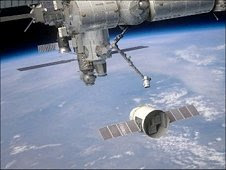The SpaceX Dragon demo flight brings a new American transportation vehicle onto the scene for travel to and from the International Space Station. Currently there are other ways to reach station, however only one vehicle, the Russian Soyuz, offers return capability. The SpaceX Dragon adds a welcome additional option for the transport of supplies and research equipment from the station to the ground.
The demo flight, which launched on May 22, 2012, is the first Commercial Orbital Transportation Services, or COTS, vehicle to journey to the station. People from around the country may watch this flight and mission for historic significance, but select students are following along with a more personal interest. This is because Dragon carries the Student Space Flight Experiments Program, or SSEP, Mission 1 investigations to the station.
These SSEP studies come from 12 communities around the U.S. and were whittled down from 779 proposals to the final 15 manifested for this flight. Participating students designed their own experiments using flight-approved fluids and materials. These then were loaded into NanoRacks modules for power and data capabilities while operating aboard station. ' What has scientists, like those at NASA’s Glenn Research Center, excited about this flight, however, is not what went up, but what is planned to come down. The Dragon's ability to increase the capability for returning experiments and hardware from the space station to Earth will enable researchers to have more frequent travel options for their investigations.
"This is a very important mission for us," said Fred Kohl, research project manager for the International Space Station and Human Health Office at Glenn. "The most important aspect is the return delivery to Earth. In general, nowadays, launching stuff to the station is not a problem. This vehicle will ensure we can get back our supplies and experiment hardware."
The demo flight, which launched on May 22, 2012, is the first Commercial Orbital Transportation Services, or COTS, vehicle to journey to the station. People from around the country may watch this flight and mission for historic significance, but select students are following along with a more personal interest. This is because Dragon carries the Student Space Flight Experiments Program, or SSEP, Mission 1 investigations to the station.
These SSEP studies come from 12 communities around the U.S. and were whittled down from 779 proposals to the final 15 manifested for this flight. Participating students designed their own experiments using flight-approved fluids and materials. These then were loaded into NanoRacks modules for power and data capabilities while operating aboard station. ' What has scientists, like those at NASA’s Glenn Research Center, excited about this flight, however, is not what went up, but what is planned to come down. The Dragon's ability to increase the capability for returning experiments and hardware from the space station to Earth will enable researchers to have more frequent travel options for their investigations.
"This is a very important mission for us," said Fred Kohl, research project manager for the International Space Station and Human Health Office at Glenn. "The most important aspect is the return delivery to Earth. In general, nowadays, launching stuff to the station is not a problem. This vehicle will ensure we can get back our supplies and experiment hardware."
Read more on http://www.nasa.gov/mission_pages/station/research/news/SpaceX_Dragon.html

No comments:
Post a Comment